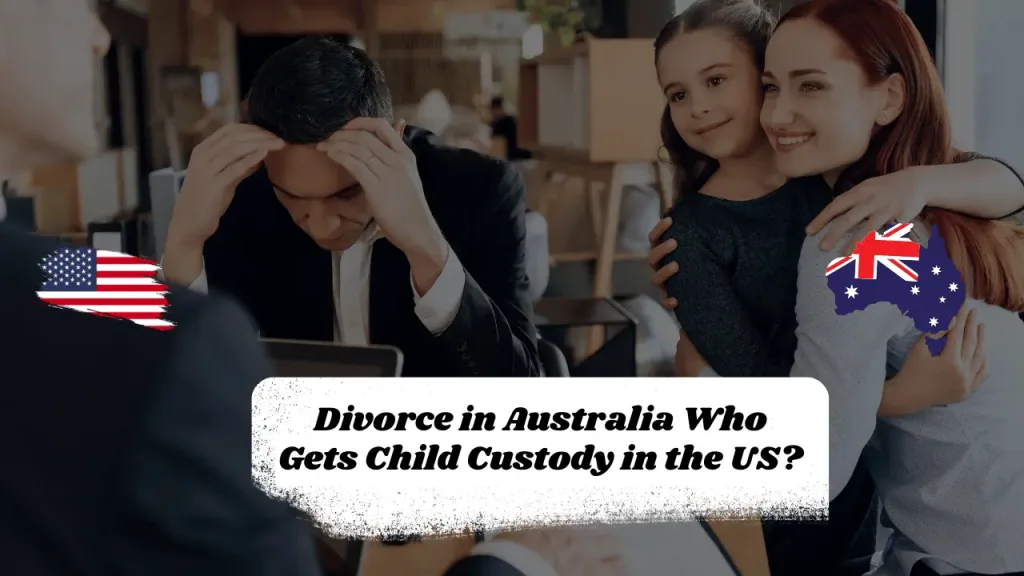Divorce in Australia Who Gets Child Custody in the US?
In 2023, over 10 million Australians lived overseas, with the US being a popular destination. For divorced parents, voyaging custody laws across these jurisdictions can be daunting. This article simplifies the complexities of child custody when divorce occurs in Australia, but custody is contested or needs enforcement in the US.
Custody Laws in Australia
In Australia, child custody decisions are guided by the Family Law Act 1975, emphasizing the child’s best interests. Key principles include:
- Equal Shared Parental Responsibility: Both parents are assumed to share responsibilities unless proven harmful to the child.
- Focus on the Child: Decisions revolve around ensuring the child’s safety, well-being, and meaningful relationships with both parents, wherever possible.
- Parenting Plans and Orders: Parents are encouraged to agree on parenting plans, but the court can issue orders if disputes arise.
Table of Contents
Who Gets Custody in the US?
If parents relocate or custody needs to be determined or enforced in the US, local laws apply. However, several factors come into play:
1. Jurisdictional Challenges
The US recognizes custody orders from other countries under the Hague Convention on International Child Abduction. Australian custody rulings are usually enforceable, but disputes may arise if one parent claims US jurisdiction.
2. Best Interests of the Child
US courts, like Australian ones, prioritize the child’s best interests. However, each state interprets this standard slightly differently, considering:
- The child’s relationship with each parent.
- Each parent’s ability to provide stability.
- The child’s preferences (in some cases).
3. Legal Custody vs. Physical Custody
US courts distinguish between legal and physical custody:
- Legal custody: Decision-making rights about the child’s upbringing.
- Physical custody: Where the child resides.
Shared custody arrangements are common unless one parent can demonstrate the other poses a risk to the child’s welfare.
Related Articles For You:
How to Get Temporary Custody of a Child in Louisiana? Step-by-Step Guide

Types of Custody in the US
Legal Custody
Involves the right to make major decisions about the child’s life, such as education, healthcare, and religious upbringing. It can be:
- Sole legal custody: Granted to one parent.
- Joint legal custody: Shared between both parents.
Physical Custody
Determines where the child will live. It can be:
- Sole physical custody: The child primarily resides with one parent.
- Joint physical custody: The child spends significant time with both parents.
Factors Considered for Custody
- Child’s Best Interests: Courts prioritize the child’s safety, well-being, and stability.
- Parent-Child Relationship: The bond between the child and each parent.
- Parental Ability: The ability of each parent to meet the child’s needs, including emotional, educational, and physical support.
- Child’s Preference: Older children may have their preferences considered, depending on their age and maturity.
- History of Abuse or Neglect: Any evidence of domestic violence or substance abuse heavily influences decisions.
- Stability: The parent who can provide a stable home environment is often favored.
Shared Custody Trends
In most states, courts aim for shared custody arrangements to ensure children maintain strong relationships with both parents unless there are compelling reasons otherwise (e.g., abuse or neglect).
Differences Between US States
Each state has its own custody laws, and terms like “custody” may be replaced with “parenting time” or “responsibility” (e.g., California uses “parental responsibility”). For example:
- In California, the courts often prefer joint custody unless proven harmful.
- In Texas, there’s a presumption that both parents should be named “joint managing conservators,” which is similar to joint custody.
- In New York, the courts may favor one parent for primary physical custody, especially if they have been the child’s primary caregiver.
Australia and Divorce Impact
If you’re divorcing in Australia, custody decisions align with the concept of “parental responsibility,” but it may still be relevant to US courts if one parent relocates to the US. International custody issues may fall under the Hague Convention on International Child Abduction, ensuring custody orders from Australia are respected in the US.
Long-Distance Parenting Plans
When parents live in separate countries, courts may implement long-distance parenting plans, balancing:
- Regular video calls or online communication.
- Extended visitation periods during school holidays.
- Adjustments based on time zones and travel logistics.
Key Factors Impacting Custody Outcomes
Parental Relocation
Relocating from Australia to the US requires court approval in Australia. Without it, the parent may face legal consequences for breaching custody agreements.
Hague Convention Protections
The Hague Convention ensures children aren’t wrongfully removed from their home country. If a parent relocates without permission, the other parent can file a claim to have the child returned.
Cultural and Legal Differences
While both countries emphasize the child’s best interests, practical differences can impact custody rulings. For example, the US has state-specific laws, whereas Australia applies national laws.
Statistics on Cross-Border Custody Cases
- 70% of international custody cases involve disputes over relocation.
- 80% of parents in cross-border custody cases report challenges with maintaining consistent visitation.
- Cases involving the Hague Convention typically resolve within six months.
Conclusion
Determining child custody in the US after a divorce in Australia requires reconciling two legal systems and often involves the Hague Convention. While both nations prioritize the child’s best interests, differing legal frameworks and logistics add complexity. Seeking expert legal advice is crucial to protecting parental rights and ensuring the child’s welfare. Whether you’re considering relocating or enforcing custody orders, understanding the interplay between Australian and US custody laws is essential for a smoother process.
About the Author

Sarah Klein, JD, is a former family law attorney with over a decade of courtroom and mediation experience. She has represented clients in divorce, custody cases, adoption, Alimony, and domestic violence cases across multiple U.S. jurisdictions.
At All About Lawyer, Sarah now uses her deep legal background to create easy-to-understand guides that help families navigate the legal system with clarity and confidence.
Every article is based on her real-world legal experience and reviewed to reflect current laws.
Read more about Sarah
